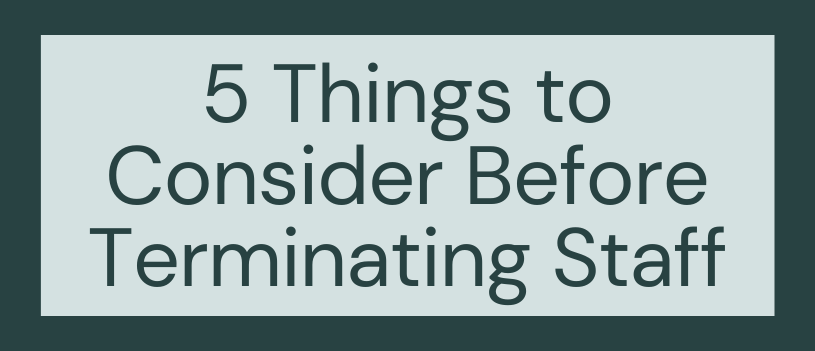One of the hardest decisions a business owner can make is terminating one of their employees. From the stress of telling the individual, finding their replacement, to being concerned about liability, it is a very fragile situation that must be handled in a fair and consistent manner. If you have to make this difficult decision, you should first take into consideration these 5 important issues.
1. Is this decision justified and not a surprise to the employee?
It is important that you first question if you are wanting to terminate based on a legitimate or justifiable reason.
The termination should not be a surprise to the employee as you should have been communicating policy or rule concerns with that individual in the past. If you are able to refer to a prior discussion that you had with the employee, then this will help support your decision. This will also help ensure that this is a legitimate termination. You should also take into account how you have handled a similar performance issue in the past with other individuals. You need to make sure that you are treating everyone fairly to avoid a potential discrimination claim.
2. Has the employee recently raised an issue of concern related to the workplace?
Prior to making a decision to terminate an employee, employers should see if the employee has recently raised any concerns regarding job terms or conditions in the workplace. The reason behind this is because the individual could have a claim against your company for a wrongful violation. If there is a short proximity of time between the reported concern and the termination, it is still possible to separate with the employee. If you have questions regarding if the concern raised by the employee could cause a wrongful termination claim, it is recommended that you speak with an employment attorney.
3. Documentation
Whenever you are considering separating with an employee, it is best to document performance and their previous conduct to ensure that you are in the best position as an employer. You should document reviews, potential warnings, and their attendance. Be sure to have in writing that the employee was previously warned regarding the performance concern and that they have been counseled.
4. Include a witness when communicating the termination decision
If possible, you should try to have a witness present during the termination meeting. This individual should ideally be a superior to the employee or someone in an independent position.
Generally, terminations should include the employee’s supervisor as well as the Human Resources representative. If your company does not have an HR department then an executive or an additional supervisor would be sufficient. During the meeting, it is important that notes are taken confirming what was discussed and that follow up communication is provided to the employee via mail or email so that the termination is clear to them and in writing.
5.Take steps to protect the company from a departing employee
The last thing to consider when terminating a staff member is making sure your company is protected.
You will need to ensure that all company property is returned to you and that the employee no longer has property or software access. You should also send the individual a letter reminding them of their obligations to protect company information.
By following these 5 steps, employers will be able to better protect their business and ensure that the termination was appropriate. If you have any employment legal concerns, it is recommended that you contact your employment attorney for additional information.
